Like so few of us, this fellow gets better with age. While Persian Ironwood is not overly encumbered with a blinding floral display, this tree makes up for it with great form, bark interest, good Fall color, and a durable disposition in the garden. Given a little time (OK, ten years or more), this tree will create a lively conversation. Best performance in the Deep South is to keep the tree in a spot that’s slightly acidic, medium moisture, and well drained. That said, this tree has been through the grinder here, from freezes, droughts, and blasting heats to floods and tornadoes and hurricanes, and they just keep on trucking.
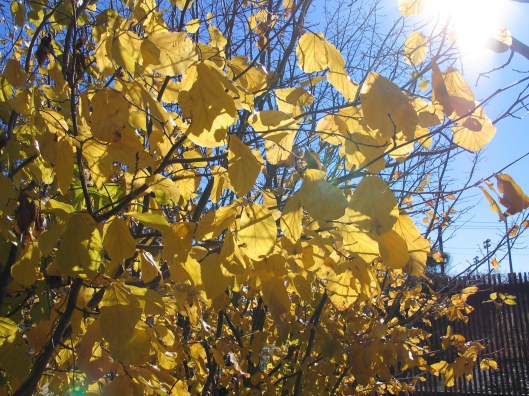
The genus name recognizes the founder F.W. Parrot (1792-1841) who was a German Naturalist. Parrotia persica is a small, single to multi-trunk deciduous tree that will top out at 20-40′ tall. The flowers lack petals and are comprised of reddish stamens surrounded by brown bracts and they appear before leaves appear. With a good hand lens, you might call them pretty. Fall color is a key feature with most showing off with a butterscotch to yellow as temperatures cool in the Fall. With age, the bark exfoliates to show green, white or tan patches beneath and it’s quite striking the older a tree gets.
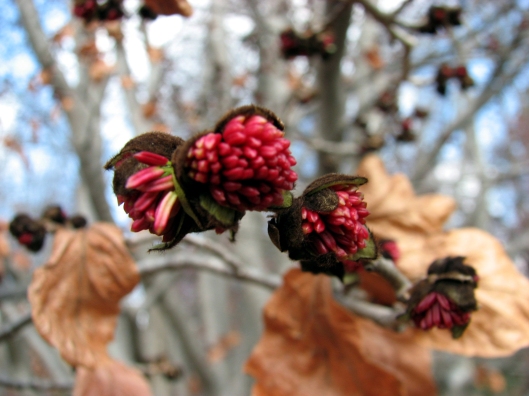
Flowers will not win best in show but are attractive on close inspection
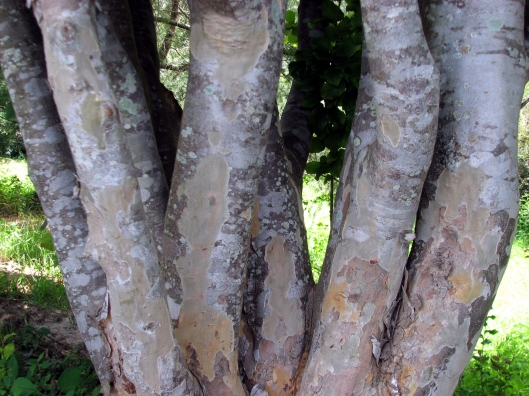
The bark is a key feature . . .
There are varieties. We’ve worked hard to get the pendulous form and have has several that never panned out. I acquired three that were fakes before finally getting the real thing. I think it’s a Kew England plant under many names but ‘Kew’s weeping’ is the real deal. It’s strongly weeping and defines the word slow. We are rooting it and if I hand you a one gallon it means I like you. Special plant for someone looking to be edgy. We have one cultivar named ‘Biltmore’ and I assume it’s from the big tree there but it looks like the straight species to me. ‘Vanessa’ is another variety, and does seem to feature a slightly different foliage look in the Fall and is perhaps a bit more upright. Don’t have an opinion on whether it’s really smaller statured. There are other varieties reported but we haven’t found them. P. persica ‘Bella’ features upright branches and widely serrated ovate leaves. These leaves are reported as deep-purple when young and then mature to a rich green colour. The leaves are also reported to twist slightly, which adds further interest. P. persica ‘Horizontalis’ is a semi-weeping variety with wide spreading horizontal branching. P. persica ‘Jodrell Bank’ is supposedly more of an upright form. P. persica ‘Pendula’ is passed around as a weeper but when folks ask, I say “not so much.” I don’t know anything about a clone called P. persica ‘Select’ which is reported to have purple-edged new leaves that become uniformly green after the first flush.
Dirr lists these and others including, ‘Burgundy,’ ‘Felicie,’ ‘Globosa,’ ‘Henny’s Dwarf,’ ‘Jennifer Teats,’ ‘Jodrell Bank,’ ‘Lamplighter’ (variegated, unstable), ‘Persian Lace’ (variegated), ‘Purple Halo,’ ‘Purple Moon,’ ‘Purple Rim,’ ‘Ruby Vase,’ and ‘Summer Bronze’. In fact, Dirr’s article is a fine read as he too finds the plant totally reliable and totally underutilized. http://www.nurserymag.com/article/nm1212-persian-ironwood-plants/

‘Vanessa’ Fall Color
Parrotia subaequalis should be a rage. It’s related to P. persica but very rare and only recently introduced. What’s odd about P. subaequalis is that it was found in eastern China, about 3500 miles away from the natural range of P. persica. Another odd fact is this tree was a recent find, first characterized by Deng in 1992. Arnold Arboretum had small plants in the garden in 2004. From that auspicious start, the plant has been scattered far and wide. We’re contributing to that. What’s sad for me is I saw the plant at the Nanjing Botanical Garden years ago but assumed it was P. persica and never gave it a second glance, chalking it up to Chinese nomenclature issues. I never caught it in the Fall because that’s what separates the two immediately. It’s brilliant red.

Parrotia subaequalis in the Fall
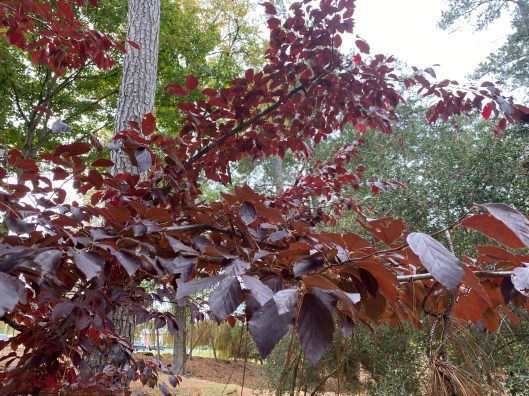
SFA Gardens Nov 2022
Easy to root and grow, we are multiplying P. subaequalis as fast as we can. If we give you one, it means we like you. There’s a great story in Arnoldia that every fan of the Hamamelidaceae should read:
I don’t think I’ve ever met a plant enthusiast who didn’t find this tree special and the conversation wanders into why it doesn’t make a top ten list somewhere. I guess it’s the lack of flowers? Maybe it’s because it’s so slow to get going? Maybe we’re just not that fond of Persia in the Deep South? It’s just not well known in the South and rarely encountered in the nursery trade, never seen at the mass markets. For whatever reason, this tough and durable tree is worthy of any well drained full sun spot in the Southern garden.
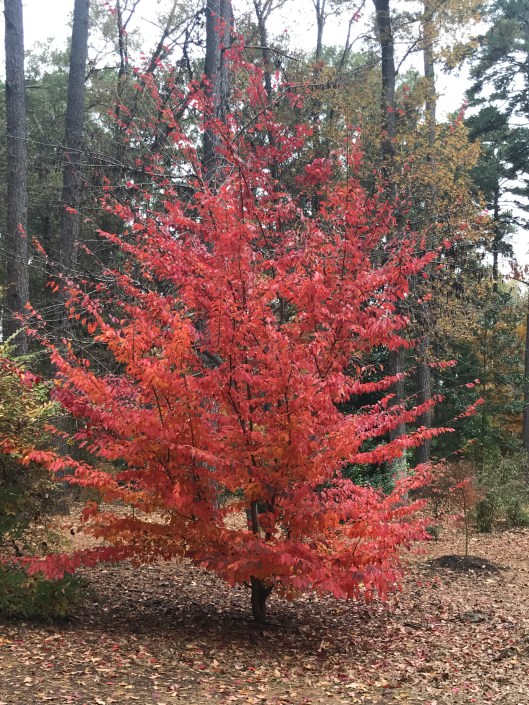


Dr Creech! Cindy (Westell) Allison here. I would love one of these trees.
LikeLike
Check with me later – I may have it propagated
LikeLike
Hi Dave, my little cutting from you (the Kew weeper) didn’t make it thru the winter. (sad face).
LikeLike
I may have plants – remind me
LikeLike
Dave, are you still in NZ? Coming to SFA this afternoon to hear Brie. If you do have a Kee Weeper, I could pick it up then. Have been enjoying your picks on kiwi production – the T-pee training thing is pretty amazing.Keith Sent via the Samsung Galaxy S7 edge, an AT&T 4G LTE smartphone
LikeLike
dont suppose anyone has a pic of the mature form of Parrotia subaequalis . cheers
LikeLike
No, and I’ve NEVER seen the tree during my many trips to China. I suspect it will get quite large with time.
LikeLike
I would bet $100 your photos of Parrotia subaequalis are actually Cotinus! Take a closer look at those petioles, not to mention the growth habit. A mix-up during uploading?
LikeLike
Hooray, you can send me $100. Does look a bit like Cotinus but these are the rarely encountered Parrotia. Been working with this interesting species since 2010. These are via the National Arb. Dave Creech
LikeLike
Hi David, as someone who grows P. subaequalis, Liriodendron is indeed correct- those photos are of Cotinus. The growth habit and leaves are textbook Cotinus and look nothing like P. subaequalis. I’d be happy to share a photo of some autumn leaves from my plant, but I’ve been having some issues replying here.
LikeLike
Well, for the sake of prudence . . . I went back to my image directory and chose an adjacent image and uploaded. Have a pic of the label as well. I sent this to a friend and he says P. subaequalis. Not sure anymore. We’ve multiplied and passed this plant along for years now. Check out the post with a close up image of the leaf. Whatcha think?
LikeLike
Hi David, that closeup looks to be P. subaequalis. On my plants the leaves are a bit more jaggedly serrated, but they are also quite juvenile. That photo above it still appears to be Cotinus; those long shoot extensions are something I’d never expect to see on Parrotia and lend it a much more leggy habit. My P. subaequalis seem to be building up in a similar manner as a witch-hazel. Thank you for promoting this wonderful species!
LikeLike